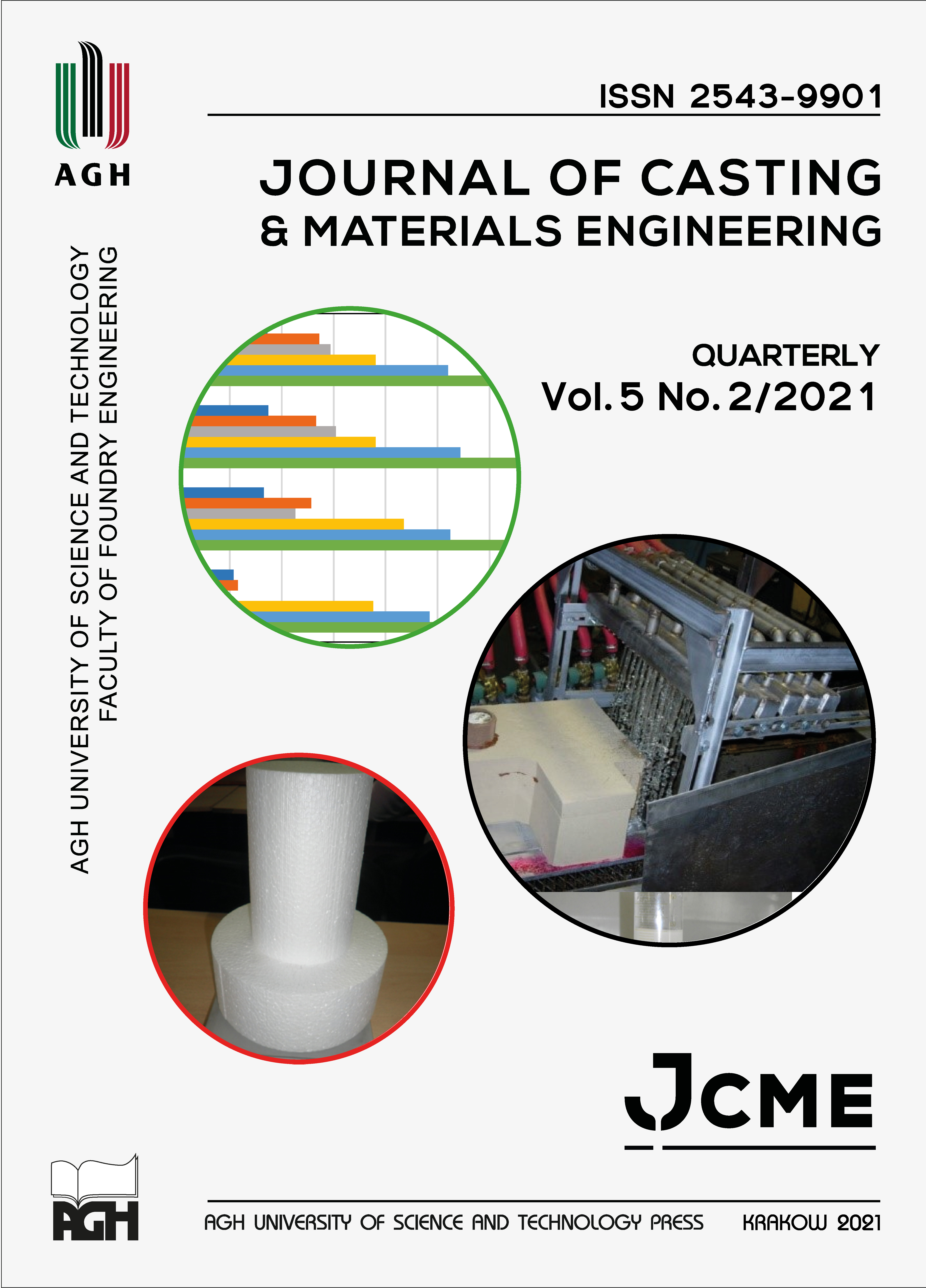The Influence of Various Matrixes on the Strength Properties of Moulding Sands with Thermally Hardened Hydrated Sodium Silicate for the Ablation Casting Process
DOI:
https://doi.org/10.7494/jcme.2021.5.2.31Abstract
The essence of ablation casting technology consists in pouring castings into single-use moulds made from the mixture of sand and a water-soluble binder. After pouring the mould with liquid metal yet while the casting is still solidifying, the mould destruction (washing out, erosion) takes place using a stream of cooling medium, which in this case is water. This paper focuses on the selection of moulding sands with hydrated sodium silicate for moulds used in ablation casting. The research is based on the use of water glass 145 and 150 as binders. As part of the research, loose moulding mixtures based on two silica sands from different sand mines with different content of binders were prepared. The review of literature data and the results of own studies have shown that moulding sand with hydrated sodium silicate hardened by dehydration is characterized by sufficient strength properties to be used in the ablation casting process. Our own research also confirmed the possibility of using these sand mixtures in terms of both casting surface quality and sand reclamation. The results presented in this paper prove that both sand grains and types of binder tested may be used as components in moulding sands devoted to ablation casting.
Downloads
References
Derui T. & Haiping L. (2011). The ancient Chinese casting techniques. 69th WFC Paper 2010. China Foundry, 8(1), 127–136.
Han Q. (2021). Ablation casting: solidification characteristics, microstructure formation, and mechanical properties. International Journal of Metalcasting. Doi: https://doi.org/10.1007/s40962-020-00544-w.
Grassi J.R. & Campbell J. (2006). Solidification microstructure of aggregatemolded shaped castings, patent US 2008/0041499 A1, United States Patent Application Publication.
Weiss D., Grassi J., Schultz B. & Rohatgi P. (2011). Ablation of Hybrid Metal Matrix Composite, Transactions of the American Foundry Society, 119, 35–41.
Grassi J., Campbell J., Hartlieb M. & Major F. (2009). The Ablation Casting Process. Materials Science Forum, 618−619, 591−594.
Weiss D., Schultz B. & Rohatgi P. (2012). Discovering Ablation: An emerging technology known as ablation can achieve fine microstructure and better mechanical properties in casting alloys. Metal Casting Design & Purchasing, January/February, 36−39.
Weiss D., Grassi J., Schultz B. & Rohatgi P. (2011). Testing the Limits of Ablation. Modern Casting, December, 26−29.
Dudek P., Fajkiel A., Reguła T. & Bochenek J. (2014). Badania nad technologią odlewania ablacyjnego stopów aluminium [Research on ablation casting technology for aluminium alloys]. Prace Instytutu Odlewnictwa, 54(2), 23–35.
Grassi J., Campbell J., Hartlieb M. & Major F. (2008). Ablation Casting. In: Yin W. & Das S.K., Aluminium Alloys: Fabrication, Characterization and Applications. The Minerals, Metals & Materials Society, Warrendale, 73–77.
Bohlooli V., Shabani-Mahalli M. & Boutorabi S.M.A. (2013). Effect of Ablation Casting on Microstructure and Casting Properties of A356 Aluminium Casting Alloy. Acta Metallurgica Sinica (English Letters), 26(1), 85–91. Doi: https://doi.org/10.1007/s40195-012-0092-6.
Taghipouriana M., Mohammadaliha M., Boutorabi S.M. & Mirdamadi S.H. (2016). The effect of waterjet beginning time on the microstructure and mechanical properties of A356 aluminum alloy during the ablation casting process. Journal of Materials Processing Technology, 238, 89–95.
Williams T.J., Galles D. & Beckermann Ch. (2013). Translating Water Spray Cooling of a Steel Bar Sand Casting. In: Proceedings of the 67th SFSA Technical and Operating Conference. Paper No. 5.4. Steel Founders’ Society of America. Chicago.
Izdebska-Szanda I., Angrecki M. & Palma A. (2015). Dobór technologii formy dla zmodyfikowanej metody ablacyjnego odlewania [Choice of mould-making technology for the modified ablation casting process]. Prace Instytutu Odlewnictwa, 55(2), 55–66.
Major-Gabryś K. (2016). Odlewnicze masy formierskie i rdzeniowe przyjazne dla środowiska. Gliwice: Wydawnictwo Archives of Foundry Engineering, Komisja Odlewnictwa PAN Katowice.
Kamińska J., Hosadyna-Kondracka M., Puzio S. & Major-Gabryś K. (2020). Jednorazowa forma odlewnicza, opis zgłoszeniowy wynalazku, PL 429888 A1. Biuletyn Urzędu Patentowego, 24, 16. Available on http://patenty.bg.agh.edu.pl/pelneteksty/PL429888A1.pdf.
Hosadyna-Kondracka M., Major-Gabryś K., Kamińska J., Grabarczyk A. & Angrecki M. (2018). Moulding Sand with Inorganic Cordis Binder for Ablation Casting. Archives of Foundry Engineering, 18(4), 110–115.
Major-Gabryś K., Hosadyna-Kondracka M., Puzio S., Kamińska J., Angrecki M. (2020). The influence of the modified ablation casting on casts properties produced in microwave hardened moulds with hydrated sodium silicate binder. Archives of Metallurgy and Materials, 65(1), 497–502.
Baliński A. (2000). Wybrane zagadnienia technologii mas formierskich ze spoiwami nieorganicznymi. Struktura uwodnionego krzemianu sodu i jej wpływ na wiązanie mas formierskich. Wydawnictwo Instytutu Odlewnictwa, Kraków.
CIATF – Comission 1.6, Alkali – Silica – Binder, 1982–1985, Düsseldorf, Germany.
Różycka D., Stechman M., Wilkosz B. & Baliński A. (2000). Szkło wodne jako spoiwo w odlewnictwie. Cz. II. Struktura. Chemik, 53(8), 215–219.
Z.Ch. Rudniki S.A. (2016). Offer specification of the product: No. 14/7.
Z.Ch. Rudniki S.A. (2017). Offer specification of the products: Sodium silicate R150.
Bryłka A. (2019). Dobór mas formierskich na formy do ablacyjnego odlewania stopów Al. AGH, Kraków [Master thesis].
Downloads
Published
Issue
Section
License
Copyright (c) 2021 Katarzyna Major-Gabryś, Sabina Puzio, Agata Bryłka, Jadwiga Kamińska

This work is licensed under a Creative Commons Attribution 4.0 International License.
How to Cite
Accepted 2021-06-23
Published 2021-07-05


